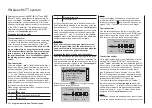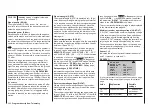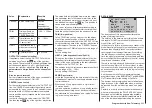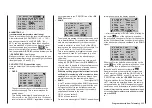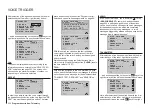
240 Program description - Telemetry
Telemetry
Read-in and settings for telemetry data
This option is available as standard on
both transmitter types.
The receiver’s settings, as well as optional
telemetry sensor settings, can be called
up and programmed in real-time by way of the »Te-
lemetry« menu. Communication with the transmitter
is accomplished over the return channel built into the
HoTT receiver.
A maximum of four sensors can be connected to the
Telemetry sockets of the following receivers, using
Y-leads where necessary: GR-12S HoTT (Order No.
33505), GR-12 HoTT (Order No. 33506), GR-16 (Or-
der No. 33508), GR-24 HoTT (Order No. 33512) and
GR-32 DUAL (Order No. 33516), provided that they
feature the current firmware.
The update capability of these and future receivers,
which can be performed by the user, will keep the
respective »Telemetry« menu up to date with the
latest version and ensure enhancement with future
functions or languages.
Note:
After registering your product at https://www.graup-
ner.de/en/service/product_registration.aspx you are
automatically informed of new updates.
Important notices:
• This manual is based on the functions available at
the time of revision of this manual.
• As already mentioned in the section entitled “Bind-
ing multiple receivers” on pages 87 and 95, it
is also possible to bind more than one receiver per
model if required. The software of
mc-16
HoTT
and
mc-20
HoTT transmitters is capable of di-
rectly managing a maximum of two receivers, and
the menu system can also be used to distribute
up to twelve transmitter control channels between
these two receivers in any configuration you wish.
However, only the receiver selected in the line
“TEL.RCV” of the “Telemetry” menu is able to
establish a telemetry connection to the trans-
mitter!
TELEMETRY
SETTING & DATA VIEW
SENSOR SELECT
RF STATUS VIEW
VOICE TRIGGER
TEL.RCV.
RCV CH1
However, that also means the inverse, that only
this receiver can be addressed through the »Te-
lemetry« menu! If necessary, therefore, the se-
lection must be changed before settings can be
made on a specific receiver.
• When adjusting the settings of the remote con-
trol, make absolutely sure that the transmitter
antenna is always far enough away from the
receiver antennae! To be on the safe side, keep
them at least one meter apart. Otherwise there
is a risk of a faulty connection to the return
channel and malfunctions will result.
• When operating a powered tug for aero-to wing,
ensure that the receiving systems and the
aerials in the two models are always at least
50 cm apart; we recommend the use of satel-
lite receivers in such situations. If you neglect
this, there is a chance of interference from the
downlink channel.
• Since the telemetric data between transmitter and
receiver is only exchanged after the fourth data
package, the data transmission requires a certain
amount of time for technical reasons, so the reac-
tion to the operating keys and changes to settings
take place with a delay. Therefore, the delay is not
due to an error.
• Programming on the model or on sensors may
only take place if the model is on the ground. Only
carry out the settings with the motor switched off
and the battery disconnected! Otherwise, unde-
sired programming cannot be ruled out.
For example, a servo test initiated accidental-
ly could cause the model to crash and cause per-
sonal injury and/or property damage. Observe the
safety instructions on pages 4 … 9 of this
manual and the respective separate manuals.
• All settings (such as fail-safe, servo direction re-
versal, servo travel, mixer and curve settings, etc.)
made through the »Telemetry« menu are stored
only in the receiver and therefore are adopted
along with it if it is implemented as a receiver in
another model. Therefore, to be on the safe side,
re-initialize your HoTT receiver if you want to use
the receiver in a different model; see “Reset” on
page 54.
• Only program the servo direction reversal, ser-
vo travel, mixer and curve settings through the
respective transmitter’s standard menus »Ser-
vo adjustment« page 112, »Dual Rate / Expo«
page 130 or page 134, »Channel 1 curve«
page 138 or 141, and so on. Otherwise, the set-
tings superimpose one another, which can lead to
complexity or even problems in the later operation.
• The channel assignment function, called “Channel
mapping”, integrated into the »Telemetry« menu
of the
mc-16
HoTT and
mc-20
HoTT trans-
mitters can also freely distribute control functions
over multiple receivers or even distribute a sin-
gle control function over multiple receiver outputs,
such as two servos per aileron instead of only one
individual servo, etc. We also recommend exer-
cising extreme during the programming.
mc
16 20
Summary of Contents for HoTT MC-16 Series
Page 1: ...Programming Manual mc 16 mc 20 HoTT 1 en mc 16 mc 20...
Page 27: ...27 For your notes...
Page 53: ...53 For your notes...
Page 61: ...61 For your notes...
Page 65: ...65 For your notes...
Page 71: ...71 For your notes...
Page 103: ...103 For your notes...
Page 107: ...107 For your notes...
Page 111: ...111 For your notes...
Page 155: ...155 For your notes...
Page 165: ...165 For your notes...
Page 201: ...201 For your notes...
Page 229: ...229 For your notes...
Page 231: ...231 For your notes...
Page 261: ...261 For your notes...
Page 265: ...265 For your notes...
Page 301: ...301 For your notes...
Page 327: ...327 For your notes...
Page 328: ...328 For your notes...

